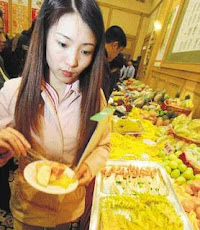CECIL Street – or See See Kai in Cantonese – is a name you will not find on today's map because it has been renamed Jalan Hang Lekiu.
It is one place in the city centre that is rich and colourful with history. Many of the buildings here were built at the turn of the last century and certain parts of it are still standing – a legacy of the migrant Chinese architecture of the late 1800s and early 1900s.
Its association with Chee Cheong Kai or Petaling Street in Chinatown made it a tourist attraction, which is heavily promoted abroad.
So, when it comes to food, Cecil Street would hardly disappoint you. As for me, the street brings back many sweet memories of school days in my teenage years.
 Tourist trap: Cecil Street, which is now known as Jalan Hang Lekiu, is an endearing destination for tourists from all over the world
Tourist trap: Cecil Street, which is now known as Jalan Hang Lekiu, is an endearing destination for tourists from all over the worldI remember my aunt Lorraine used to pack lunch from some of the makan places here back in the mid-70s – and some of the well-known eateries in the city centre are found here.
So, first off, I would like to start with the much-hyped and talked-about Koon Kee noodle shop. It is not hard to locate this eatery because it was widely publicised by the local and foreign media.
To give you a better picture, the shop is in the centre row opposite Petaling Street's Hong Leong Bank. Now, this particular makan place is said to be pricey.
I found the allegations baseless because the bad rap was made good by the shop's offering of excellent food. For RM4 a plate, you can hardly complain.
So, to sample the legendary Koon Kee wantan noodles, I roped in my regular makan kaki C.M. Khor, who is familiar with the history of Cecil Street.
“Eh, Sam, this place still hasn't lost its touch lah! The char siew is as good as I first tasted it back in the mid-60s,” he said. The shop, he added, is now in the hands of the second-generation.
As for the generous portion and the juicy and succulent char siew, I recall my aunt packing mar meen (double helping) from Koon Kee as her lunch treat for the whole Cheong clan back when she was working in a multinational company in Brickfields.
Apart from wantan noodles, Koon Kee also serves rice and its famed swey kow (meat dumplings). But, since I had plans to sample another legendary food stall in the neighbourhood, I gave that a pass.
For RM11.40 (two single-helping plates of wantan noodles and two drinks), the Koon Kee experience was money well spent. My follow-up trip would be a session to sample its swey kow.
Now, many of the good makan places in Cecil Street have relocated. One of them was Lee Thong Kee chicken hor fun that shifted to Jalan Tun H.S. Lee.
If you love lorng-yuk (barbecued pork jerky), the Kiew brothers are found here. They occupy a pre-war shop house and if you follow your sense of smell, it would lead you right to it.
One of my favourite Chinese confectionery shops here is Fung Wong biscuit, which is well known among the old-school city dwellers.
Here, you can find some of the best Chinese pastries like the char siew sou, tan tart (egg tart) and kaya kok (kaya puff). Prices are also very reasonable and folks who know this place would usually pack plenty of biscuits and pastries for takeaway.
Moving on, one of my favourite beef noodles stalls is found here in Cecil Street. Housed in what was previously a pre-war shop house, Kiew Yee ngau chap fun is a makan place that has stood the test of time.
 Healthy business: The late breakfast crowd at Koon Kee noodle shop in Cecil Street.
Healthy business: The late breakfast crowd at Koon Kee noodle shop in Cecil Street.As I recall, my aunt used to take me for lunch in this particular outlet back in the mid-70s. Now it is manned by the owner's son, who can be seen preparing his orders at a stall at the far left corner in Tang's food centre.
It is no mistake that the same fella, who is in his mid-50s, is now the man in charge. You can savour the ngau chap meen (beef offal noodles) either in soup or in dry gravy.
At RM6 a bowl, prices were inflated but the saving grace here is the good taste and reasonable portion. Kiew Yee noodle stall is one of the very few beef noodle sellers in the city that can give you a good portion of tender beef fillet with your order.
Now, if I may add, the stall's hand-made beef balls are so springy, I would say that they are the best I have ever tasted and so far, no makan place has come close.
Here in Cecil Street, you can find food from dawn to dusk. There is simply too much to cover and well, it seems that I may have left out the famous porridge next to Koon Kee and the Hokkien mee seller next to it.
But rest assured, I will cover these, especially for you, my readers out there, in my next “Samo super supper special food trail”.
To get there, hop onto an LRT and get off at the Pasar Seni station. Cecil Street is about a 10-minute walk from there. And, for those who have a cell-phone navigate by voice GPS system, key in the following coordinates: Koon Kee (Long N 03 08” 669', Lat E 101 41” 879'), Tang's Food Centre – Kiew Yee beef noodles (Long N 03 08” 669', Lat E 101 41” 880').




















